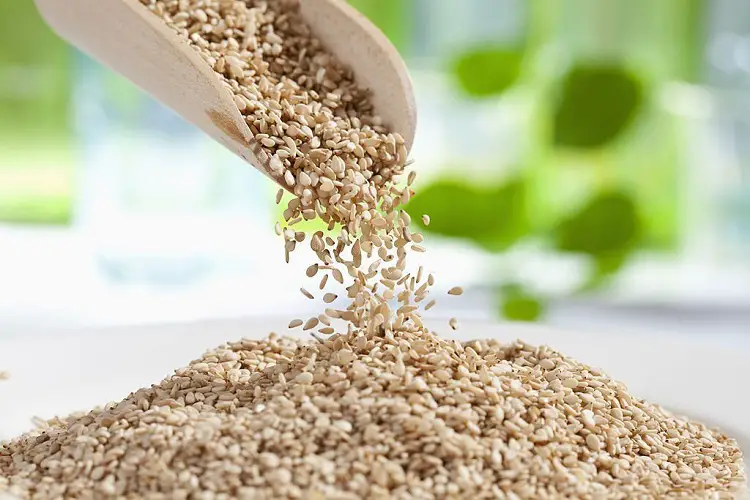Have you ever wondered how to introduce Sesame to baby, and you are scared and skeptical about it due to the increase in sesame allergy?
Keeping your baby away from Sesame is off-topic since Sesame is present in the food they consume daily, and the ingredients are not currently listed on food labels.
It is essential to introduce Sesame to your baby appropriately because its presence is masked on food labels.
You can introduce Sesame to your baby as a homemade recipe, early allergen introduction powder, and early allergen puff.
Read on to learn about Sesame, how to introduce Sesame to a baby, and much more.
Table of Contents
- Sesame: Everything You Need To Know
- When To Introduce Sesame To Baby
- How To Introduce Sesame To Baby
- Why You Should Introduce Sesame To Your Baby
- FAQ’s
- Conclusion
Sesame: Everything You Need To Know
Sesame is a plant with seeds borne in pods, when ripe, burst open to reveal an abundance of oil-packed seeds.
Seeds of Sesame have been used as food since ancient times, as well as for medicine and oil for lamplight in Asia, where historians believe it was first cultivated.
Sesame is used in cooking worldwide, and you can sprinkle its tiny seeds on bagels, burgers, buns, salads, sushi, and all sorts of dishes.
It can also be used as condiments and aromatics to make seasonings like gomasio and za’atar.
You can blend it into paste-like tahini and sauces like a mole; stir it into soups and stews as thickeners and bake it into bread and desserts like halvah, pastel, and til ka laddu.
When To Introduce Sesame To Baby
Sesame can be introduced to babies as soon as you feel that your baby is old enough to start swallowing food, and this should be from 4-6 months old, according to the 2020 USDA Dietary guidelines.
Though NHS believes that your baby should be up to 6 months before weaning with solid foods commences and when introducing sesame seeds to your baby, start with crushed or ground sesame seeds.
How To Introduce Sesame To Baby

Do not offer Sesame to your baby in its unprocessed form as this may cause or predispose your baby to choking.
It will be healthier and less risky if Sesame is introduced to your baby in a less mild form.
Solid Sesame should be introduced with foods your baby is already familiar with.
You could mix your baby’s sesame seed with yogurt or sprinkle it on top of a plate of scrambled eggs.
When introducing your baby to chickpeas and olive oil, you can also use the hummus method because one of the key ingredients in hummus is tahini, made using sesame seeds.
Introduction to Sesame by your baby can be done using any of the three methods listed below.
Homemade Recipes
You could introduce Sesame to your baby using homemade recipes like homemade hummus.
The beautiful thing about homemade hummus is the absence of the high sodium contents in commercially prepared ones.
The use of tahini is a better option, and it is a better sesame seed paste and can be used to start the introduction because it has the same texture as peanut butter.
Remember to thin the tahini with yogurt or applesauce before you feed your baby with it so that it doesn’t get lodged to the top of the mouth and then make your baby prone to choking hazards.
These can be fed to your baby using a spoon, softened crackers, and bread.
Early Allergen introduction powder
Food allergen introduction powder like spoonfulONEs Mix-ins is also an easy and effective way of introducing Sesame to your little one and other allergic foods as early as four months.
You can easily add them to the breast milk you feed your baby or even their formula, bottle-feed, or mix them into pureed, applesauce, or oatmeal.
Early Allergen puffs
There can be a transition as your child grows from allergen powders to more solid puffs.
Products like SpoonfulONE Puffs are designed and manufactured with procedures and ingredients that make them easy to dissolve with saliva and can be given to a growing infant.
When going for puffs, please do not give them to babies less than six months of age.
Read: When to introduce solid food to your baby
Why You Should Introduce Sesame To Your Baby
Sesame contains many nutrients that are informally regarded as a powerhouse of nutrients, and its nutrient contents are essential for your baby’s survival.
It belongs to the category of oil-rich seeds. It contains many vitamins, minerals, and healthy fats like lignans and phytosterols that are antioxidant, anti-cancerous, and anti-inflammatory.
The nutrient content of Sesame includes protein, fiber, calcium, iron, copper, magnesium, manganese, and zinc.
These may even be minute in infant diets hence the need for augmentation with nutrient-rich food like Sesame.
These nutrients found in the sesame seeds are readily accessible when the sesame seeds are grounded into powders or paste enabling easy assimilation and absorption by the body.
Another excellent way to benefit from Sesame is by consuming sesame oil. Along with its delicious taste, sesame oil has an added advantage: it can withstand high temperatures without going rancid.
Read: Healthy finger foods for one year old
FAQ’s
Is Sesame a common choking hazard for babies?
No. While sesame seeds are not a choking hazard, tahini (sesame paste) can be. To reduce the risk, mix tahini with water, applesauce, breast milk, or formula before serving.
As always, set up a safe eating environment, stay within arm’s reach of your baby during meals, and follow our age-appropriate serving suggestions before serving tahini to your baby.
Is Sesame a common allergen?
Yes. There is increasing evidence that Sesame is a common cause of anaphylaxis in Southwest Asia and North Africa.
For example, Sesame is the third most common food allergen in Israel. It is now the ninth most common food allergen in the United States.
It’s best to introduce Sesame for allergen use ground sesame seeds or sesame paste (known as tahini), since whole sesame seeds may not be chewed well enough to expose the baby to the proteins.
Tahini, made from unhulled sesame seeds is the best choice for allergen introduction because it will contain more protein and expose the baby to a broader range of allergenic proteins (allowing him to develop tolerance to all these proteins).
Related Posts:
- Gerber vs Cerelac
- Can I Mix Cerelac with Pap?
- Cerelac vs Nestum – Which is Better?
- Best homemade juice for babies
Conclusion
You have learned how to introduce Sesame to baby, and I believe you know better how to go about it, right?
Remember that offering Sesame to your baby in its unprocessed form is out of place, as this may cause or predispose your baby to choking.
It will be healthier and less risky if Sesame is introduced to your baby in a less mild form.
Start introducing solid Sesame with foods your baby is already familiar with. You could mix your baby’s sesame seed with yogurt or sprinkle it on top of a plate of scrambled eggs.
When introducing your baby to chickpeas and olive oil, you can also use the hummus method because one of the key ingredients in hummus is tahini, made using sesame seeds.
